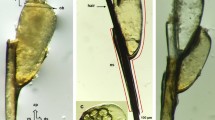Summary
Fully differentiated kinetes, average length 17.6μm, appeared in the haemolymph of engorged nymphs usually 17 to 20 days after repletion. Kinetes were observed at first in the salivary glands on day 18 after repletion. The kinetes then transformed into fission bodies of about 10μm in diameter, mainly in type III alveoli and less frequently in type II alveoli. The fission bodies grew up to a size of about 20μm after several divisions of their nucleus. At this time the ticks moulted and no further development occurred until activation. Shortly before infestation the salivary glands began to proliferate, and rapid growth of the fission bodies was observed, especially in young ticks where development of ‘infective particles’ (‘sporozoites’) was concluded within two days. Development in feeding adult ticks apparently occurred in four major steps: (1) Division of primary fission bodies (sporonts) into numerous secondary fission bodies (‘primary sporoblasts’), (2) division of secondary fission bodies into tertiary fission bodies (‘secondary sporoblasts’), (3) production of particles (‘sporozoites’) by tertiary fission bodies and release of particles into the saliva, and (4) degeneration of fission bodies and their host cell but further release of particles.
The host cell was stimulated to giant growth, thus its diameter increased, on average, from 15 to 110 μm. Heavy infections resulting from parasitaemias of >40% caused disease and mortality in the tick population. Development was much retarded by aging. In ticks starved for six months ‘sporozoites’ did not develop before day five to seven of infestation. ‘Sporozoites’ may not develop at all in six to nine month old female ticks during the infestation period. The significance of the described developmental stages ofT. annulata was discussed and a sexual generation postulated. The hypothetic development ofT. annulata in its tick vector was illustrated.
Similar content being viewed by others
Literatur
Bhattacharyulu, Y., Chaudhri, R.P., Gill, B.S.: Transtadial transmission ofTheileria annulata through common ixodid ticks infesting Indian cattle. Parasitology71, 1–7 (1975)
Brocklesby, D.W., Bailey, K.P., Vidler, B.O.: The transmission ofTheileria parva (Theiler, 1904) byRhipicephalus carnivoralis Walker, 1965. Parasitology56, 13–14 (1966)
Cowdry, E.V., Ham, A.W.: Studies on East Coast fever. I. The life cycle of the parasite in ticks. Parasitology24, 1–49 (1932)
Dyakonov, L.P., Godzhaev, A.N.: Development ofTheileria annulata inHyalomma anatolicum. Veterinariya48, No. 5, 61–65 (1971)
Friedhoff, K.: Lichtmikroskopische Untersuchungen über die Entwicklung vonBabesia ovis (Piroplasmidea) inRhipicephalus bursa (Ixodoidea). I. Die Entwicklung in weiblichen Zecken nach der Repletion. Z. Parasitenkd.32, 191–219 (1969)
Hadani, A., Pipano, E., Dinür, Y.: Studies on the transmission of Theileria annulata by ticks (Ixodoidea, Ixodidae). 2. Hyalomma detritum — Development of the parasite in the salivary glands of the adult tick. J. Protozool.16, Suppl. 37 (1969)
Hadani, A., Tsur, I., Pipano, E., Senft, Z.: Studies on the transmission ofTheileria annulata by ticks (Ixodoidea, Ixodidae). I.Hyalomma excavatum. J. Protozool.10, Suppl. 35 (1963)
Holbrook, A.A., Anthony, D.W., Johnson, A.J.: Observations on the development ofBabesia caballi (Nuttall) in the tropical horse tickDermacentor nitens Neumann. J. Protozool.15, 391–396 (1968)
Martin, H.M., Barnett, S.F., Vidler, B.O.: Cyclic development and longeviety ofTheileria parva in the tickRhipicephalus appendiculatus. Exp. Parasitol.15, 527–555 (1964)
Mehlhorn, H., Weber, G., Schein, E., Büscher, G.: Elktronenmikroskopische Untersuchung an Entwicklungsstadien vonTheileria annulata (Dschunkowsky und Luhs, 1904) im Darm und in der Hämolymphe vonHyalomma anatolicum excavatum (Koch, 1844). Z. Parasitenkd.48, 137–150 (1975)
Purnell, R.E., Joyner, L.P.: The development ofTheileria parva in the salivary glands of the tick,Rhipicephalus appendiculatus. Parasitology58, 725–732 (1968)
Reichenow, E.: Über die Entwicklung vonTheileria parva, dem Erreger des Küstenfiebers der Rinder, inRhipicephalus appendiculatus. Zentralbl. Bakteriol. (Orig. A)140, Beiheft, 223–226 (1937)
Reichenow, E.: Der Entwicklungsgang des Küstenfiebererregers im Rinde und in der übertragenden Zecke. Arch. Protistenkd.94, 1–56 (1940)
Reichenow, E.: Zui Kenntnis des Küstenfiebererregers der Rinder. Dtsch. Tierärztl. Wochenschr.49, 546–547, 594–595 (1941)
Riek, R.F.: The life cycle ofBabesia bigemina (Smith and Kilborne, 1893) in the tick vectorBoophilus microplus (Canestrini). Aust. J. Agric. Res.15, 802–821 (1964)
Schein, E.: On the life cycle ofTheileria annulata (Dschunkowsky and Luhs, 1904) in the midgut and hemolymph ofHyalomma anatolicum excavatum (Koch, 1844). Z. Parasitenkd.47, 165–167 (1975)
Schein, E.: Zum Entwicklungszyklus vonTheileria annulata (Dschunkowsky, Luhs, 1904) in der ÜberträgerzeckeHyalomma anatolicum excavatum (Koch, 1844). Habil.-Schrift, FU Berlin (1976)
Schein, E., Büscher, G., Friedhoff, K. T.: Lichtmikroskopische Untersuchungen über die Entwicklung vonTheileria annulata (Dschunkowsky und Luhs, 1904) inHyalomma anatolicum excavatum (Koch, 1844). I. Die Entwicklung im Darm vollgesogener Nymphen. Z. Parasitenkd.48, 123–136 (1975)
Sergent, E., Donatien, A., Parrot, L., Lestoquard, F.: Cycle évolutif deTheileria dispar du boeuf chez la tiqueHyalomma mauritanicum. Arch. Inst. Pasteur Algér.14, 259–294 (1936)
Tatchell, R.J.: A modified method for obtaining tick oral secretion. J. Parasitol.53, 1106–1107 (1967)
Weber, G.: Glykolmethacrylat-Einbettung und 1–2 μ-Schnitt-Technik für Zeckengewebe und ganze Zecken. Z. Parasitenkd.40, 295–306 (1972)
Weber, G.: Cytologie der Piroplasmen im Vektor. Ultramorphologische und enzym-ultracytochemische Untersuchungen an Entwicklungsstadien vonBabesia bigemina, Babesia ovis undTheileria annulata (Protozoa: Apicomplexa) in Darm, Hämolymphe, Ovar und Speicheldrüsen von Über-trägerzecken (Ixodoidea). Habil.-Schrift, Tierärztliche Hochschule Hannover (1978)
Weber, G., Friedhoff, K.: Cytochemische Untersuchungen an Merozoiten vonBabesia ovis undBabesia bigemina (Piroplasmidea) in der Zeckenhämolymphe. Z. Parasitenkd.32, 181–190 (1969)
Weber, G., Friedhoff, K.: Lichtmikroskopische Untersuchungen über die Entwicklung vonBabesia ovis (Piroplasmidea) inRhipicephalus bursa (Ixodoidea). II. Cytochemische Untersuchungen an differenzierten Merozolten in den Speicheldrüsen weiblicher Zecken. Z. Parasitenkd.35, 218–233 (1971)
Author information
Authors and Affiliations
Additional information
Gefördert von der Deutschen Forschungsgemeinschaft (DFG)
Rights and permissions
About this article
Cite this article
Schein, E., Friedhoff, K.T. Lichtmikroskopische Untersuchungen über die Entwicklung vonTheileria annulata (Dschunkowsky und Luhs, 1904) inHyalomma anatolicum excavatum (Koch, 1844). Z. Parasitenkd. 56, 287–303 (1978). https://doi.org/10.1007/BF00931721
Received:
Issue Date:
DOI: https://doi.org/10.1007/BF00931721




